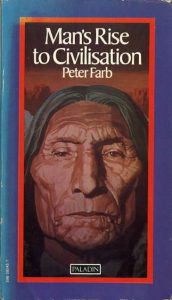Book Review: ‘Man’s Rise to Civilisation’
Social Evolution
‘Man’s Rise to Civilisation’, by Peter Farb. Secker & Warburg, 55s.
 Those whose ideas about North American Indians have been moulded by Western films and novels will find Peter Farb’s book a revelation. The author takes his readers on a three-dimensional trip, north to south, east to west, and past to present, calling on all the familiar names like Cheyenne, Apache, Pawnee, Seminole, Iroquois, Eskimo, and Aztec, as well as lots of lesser-known ones. He sheds a lot of light on their customs and behaviour.
Those whose ideas about North American Indians have been moulded by Western films and novels will find Peter Farb’s book a revelation. The author takes his readers on a three-dimensional trip, north to south, east to west, and past to present, calling on all the familiar names like Cheyenne, Apache, Pawnee, Seminole, Iroquois, Eskimo, and Aztec, as well as lots of lesser-known ones. He sheds a lot of light on their customs and behaviour.
When ‘white’ men invaded America they met a confusing babel of languages and a multiplicity of different social organisations. They experienced varying reactions from the different groups of Indian natives. Some were warlike, others peaceful; some honoured agreements, others broke them; some were passively resistant, others fled; some were regarded as noble red men and others as ignorant savages. Some were organised under powerful chiefdoms with strong military institutions. Some were groups of families which looked to a senior member for advice which they did not necessarily have to take, and in consequence did not consider themselves bound by agreements supposedly made on their behalf. Some had well-defined social classes with a state machine to protect the interests of the privileged class. Farb classifies these under four main headings: 1. The Band, 2. The Tribe, 3. The Chiefdom and 4. The State—the first two with sub-headings.
Farb shows that the stage of social organisation to which each Indian group had evolved determined its attitude to the white explorers and invaders, from Columbus and Cortes to the Puritan pilgrims and the westward-thrusting farmers and traders. He also explains the effects of the white man’s institutions on the native organisation: how fur trading affected the communal organisation of the Indians in the Hudson Bay and Labrador areas and how the introduction of the horse and the gun affected the Plains Indians.
The book attempts to explain social evolution by cultural development and Farb understands culture to be “that complex whole which includes knowledge, belief, art, law, morals, custom and other capabilities and habits acquired by man as a member of society.” Those ‘other capabilities’ must include technology; in fact, Farb says so later in his book when he refers to cultural reasons as “social, political, economic, and technological” ones.
To explain social organisation by cultural development is like explaining that the reason a man crosses a road is to get to the other side—it leaves us wondering why he wanted to get to the other side. For a more complete understanding of social organisation we must isolate one part of the culture, and without ignoring the other parts see how its influence is decisive in determining social development.
If we isolate the technological aspect we can see how a social group has been able to extend its control over nature by the discovery and invention of tools and processes and we shall see how this aspect is the foundation of all human activities, determining their condition and defining their limits.
Peter does not miss the technological aspect, far from it, but by failing to emphasise its fundamental importance he lessens the weight of his words. By lumping it in with what we would call ‘the social superstructure’ he blurs what would otherwise be an excellent definition.
With the advantage of an additional hundred years of archaeological research behind him, Farb shrugs aside the classifications of men like Lewis Morgan and Frederick Engels as being too general to be useful. We appreciate that when people at different levels of social organisation come into contact they absorb aspects of one another’s culture and this makes the pieces of the historical jig-saw more difficult to piece together.
Man’s rise to civilisation has not been determined by his laws, arts, customs, religions, etc. but by his increasing inventiveness and adoption of more efficient tools, machinery and techniques of production. Although much of what Morgan, Engels, and others of their day wrote is outdated, the historical milestones they uncovered are still there to point the way. If history is to have a meaning it must reveal the motivating factor of social development so that we may gauge progress into the future.
Just as the digging stick and the rabbit snare were fundamental to the social organisation of the Shoshonean Indians, so modern methods of production are fundamental to capitalism and are the driving force towards Socialism.
Farb may be able to prove that man has not travelled the road to civilisation by a strict rotation of steps, there may have been leaps forward or steps backward, but he cannot prove that the type of social organisation of any people has not been limited by the technology of the time and place.
The latter chapters of the book deal with the recent aspirations of the Indians and the attempts at a cultural revival. These read like the story of the Maccabees and other people who have been swamped by a society at a higher level of social development. They looked for a messiah to lead them back to the good old times. But Farb’s portrayal of Karl Marx as a messiah, Lenin as a prophet, and Stalin and Trotsky as disciples is amusing.
W. Waters
